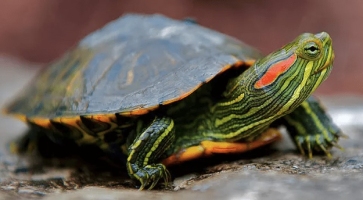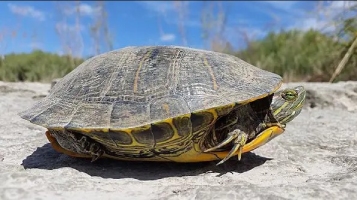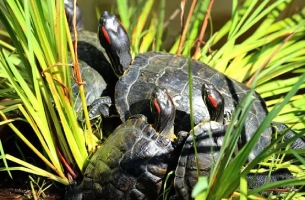Red-eared sliders are colorful North American turtles distinguished by the red stripe on their ears. While some individuals admire them as pets, they have traveled far and wide from the homeland through releases. In locations such as Bermuda, released turtles thrive and rapidly shift habitats with their aggressive feeding strategy. They consume different plants, fish, and insects, thereby making the new habitat their area of dominance. Others refer to them as invasive, yet others characterize them as survivors.
These turtles began in the warm waters of the Mississippi River Basin, flourishing in calm ponds and lakes. The 20th-century pet trade boom made them affordable and popular worldwide until owners released them into the wild. Now, hundreds of them have reached Bermuda, Australia, and Europe, with hundreds crowding Bermuda’s ponds from dumped pets starting colonies. Skilled at climbing and burrowing, they follow fresh water and lay eggs prolifically, turning one turtle into a growing, hard-to-control population.
Impact on Native Species

Red-eared sliders significantly disrupt local wildlife with their aggressive feeding habits. In Bermuda, they prey on killifish, which are crucial for controlling mosquito populations. With fewer killifish, mosquito numbers rise, posing problems for ponds and people nearby. Mosquitofish, another key species, also suffer from this competition and predation.
Native predators face challenges, too, as sliders lack natural enemies in these new regions. Birds like coots lose nests when sliders bask on them, crushing eggs or eating chicks. Native turtles, such as diamondbacks, struggle to compete for food and basking spots. This imbalance creates a challenging environment for species that belong there.
Ecosystem Disruption
The disruption caused by red-eared sliders extends beyond individual species. They eat aquatic plants, clearing ponds and leaving fish without hiding places to escape predators. Insects multiply without cover, setting off a ripple effect through the food chain. This shift removes predators and boosts prey, altering the natural order in strange ways.
Even in brackish ponds with some salt, sliders manage to thrive where others falter. They bask on logs or banks, warming up to eat more and adding waste that clouds the water. This takeover throws ecosystems off balance, making ponds less hospitable for native life. Their presence transforms habitats into something entirely new.
Adaptation and Survival

Red-eared sliders have adapted to survive in diverse surroundings. Being cold-blooded, they warm themselves to a good body temperature in the sunshine. They will eat anything in sight, from snails and aquatic vegetation to fish, with incredible diet diversity. Such diet diversity ensures that they survive even where they should not.
Their breeding behavior further consolidates their settlement in invaded ecosystems. They have several clutches annually, most notably in warm climates like Bermuda’s. They develop quickly and can survive for over 20 years with no predators to control them. This is what allows them to overtop ecosystems in which they colonize.
Human Interaction and Control
Humans introduced red-eared sliders and are now working to manage their spread. In Bermuda, pet dumping fills ponds, prompting community groups to trap them with hoop nets. These efforts catch dozens at a time, though numbers rebound due to prolific egg-laying. It’s an ongoing struggle to keep their population in check.
Scientists propose solutions like euthanasia at vet clinics for unwanted pets. Education campaigns urge owners not to release them, while some test fences to block their movement. Despite these attempts, sliders push back, proving that nature is complex to outmaneuver. People adjust strategies as the turtles adapt in return.
A Double-Edged Role

What role do red-eared sliders play in the ecosystems they invade? They overpower natives, eating resources and disrupting ponds with alarming efficiency. Mosquitoes increase, birds lose nests, and fish dwindle, challenging the natural balance significantly. Their presence doesn’t align with the ecosystems they enter.
Yet, they excel as survivors, filling gaps where other species can’t cope. They persist in polluted or altered ponds, eating whatever remains to sustain themselves. Some admire their adaptability, though they don’t belong in these spaces. Their impact varies; they are harmful to natives yet resilient in chaos.
Conclusion
Red-eared sliders weave a complex tale of unintended consequences from the pet trade. They’ve shifted from tank companions to widespread pests in places like Bermuda. They harm native species and ecosystems but adapt with impressive tenacity. Though they keep thriving, efforts to control them with traps and education persist. This story warns of meddling with nature, showing both its fragility and its strength.

